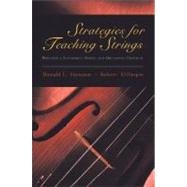
| Preface | xi | ||||
| Chapter 1 THE STRING INSTRUMENT FAMILY | 1 | (13) | |||
|
1 | (3) | |||
|
4 | (1) | |||
|
5 | (2) | |||
|
7 | (2) | |||
|
9 | (3) | |||
|
12 | (1) | |||
|
12 | (2) | |||
| Chapter 2 THE SCHOOL ORCHESTRA PROGRAM | 14 | (15) | |||
|
14 | (2) | |||
|
16 | (2) | |||
|
18 | (3) | |||
|
21 | (1) | |||
|
22 | (2) | |||
|
24 | (3) | |||
|
27 | (1) | |||
|
27 | (2) | |||
| Chapter 3 BEGINNING STRING CLASS INSTRUCTION | 29 | (34) | |||
|
29 | (1) | |||
|
30 | (1) | |||
|
31 | (2) | |||
|
33 | (6) | |||
|
39 | (1) | |||
|
40 | (2) | |||
|
42 | (3) | |||
|
45 | (1) | |||
|
45 | (2) | |||
|
47 | (1) | |||
|
47 | (2) | |||
|
49 | (3) | |||
|
52 | (1) | |||
|
52 | (4) | |||
|
56 | (1) | |||
|
56 | (2) | |||
|
58 | (1) | |||
|
58 | (1) | |||
|
59 | (1) | |||
|
59 | (1) | |||
|
59 | (1) | |||
|
60 | (1) | |||
|
60 | (3) | |||
| Chapter 4 INTERMEDIATE STRING CLASS INSTRUCTION | 63 | (34) | |||
|
63 | (1) | |||
|
64 | (1) | |||
|
65 | (1) | |||
|
65 | (1) | |||
|
66 | (1) | |||
|
66 | (1) | |||
|
66 | (1) | |||
|
67 | (1) | |||
|
68 | (1) | |||
|
68 | (2) | |||
|
70 | (12) | |||
|
82 | (1) | |||
|
82 | (1) | |||
|
83 | (1) | |||
|
84 | (1) | |||
|
85 | (1) | |||
|
86 | (6) | |||
|
92 | (1) | |||
|
92 | (2) | |||
|
94 | (1) | |||
|
95 | (2) | |||
| Chapter 5 ADVANCED STRING CLASS INSTRUCTION | 97 | (31) | |||
|
97 | (1) | |||
|
98 | (1) | |||
|
98 | (1) | |||
|
99 | (1) | |||
|
99 | (2) | |||
|
101 | (1) | |||
|
102 | (1) | |||
|
102 | (1) | |||
|
103 | (1) | |||
|
104 | (8) | |||
|
112 | (10) | |||
|
122 | (1) | |||
|
123 | (1) | |||
|
124 | (2) | |||
|
126 | (1) | |||
|
127 | (1) | |||
| Chapter 6 PLANNING THE SCHOOL ORCHESTRA REHEARSAL | 128 | (43) | |||
|
128 | (3) | |||
|
131 | (2) | |||
|
133 | (6) | |||
|
139 | (2) | |||
|
141 | (3) | |||
|
144 | (7) | |||
|
151 | (3) | |||
|
154 | (6) | |||
|
160 | (8) | |||
|
168 | (1) | |||
|
169 | (1) | |||
|
169 | (2) | |||
| Chapter 7 REHEARSAL TECHNIQUES | 171 | (24) | |||
|
171 | (1) | |||
|
171 | (1) | |||
|
172 | (6) | |||
|
178 | (1) | |||
|
178 | (3) | |||
|
181 | (1) | |||
|
182 | (2) | |||
|
184 | (1) | |||
|
184 | (1) | |||
|
185 | (1) | |||
|
186 | (1) | |||
|
187 | (2) | |||
|
189 | (4) | |||
|
193 | (2) | |||
| Chapter 8 PRACTICAL APPROACHES TO TEACHING IMPROVISATION IN THE SCHOOL ORCHESTRA | 195 | (5) | |||
|
196 | (1) | |||
|
196 | (1) | |||
|
197 | (1) | |||
|
198 | (1) | |||
|
199 | (1) | |||
|
199 | (1) | |||
|
199 | (1) | |||
| Chapter 9 STRING STUDENT RECRUITMENT AND RETENTION | 200 | (13) | |||
|
200 | (1) | |||
|
200 | (3) | |||
|
203 | (5) | |||
|
208 | (4) | |||
|
212 | (1) | |||
| Chapter 10 METHOD BOOKS AND MUSIC FOR THE SCHOOL ORCHESTRA PROGRAM | 213 | (9) | |||
|
214 | (1) | |||
|
215 | (1) | |||
|
216 | (3) | |||
|
219 | (1) | |||
|
220 | (1) | |||
|
220 | (2) | |||
| APPENDIX: ADDITIONAL PEDAGOGICAL RESOURCES | 222 | (5) | |||
|
222 | (3) | |||
|
225 | (2) | |||
| Index | 227 |
The New copy of this book will include any supplemental materials advertised. Please check the title of the book to determine if it should include any access cards, study guides, lab manuals, CDs, etc.
The Used, Rental and eBook copies of this book are not guaranteed to include any supplemental materials. Typically, only the book itself is included. This is true even if the title states it includes any access cards, study guides, lab manuals, CDs, etc.